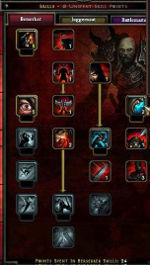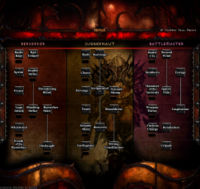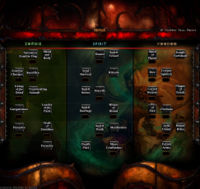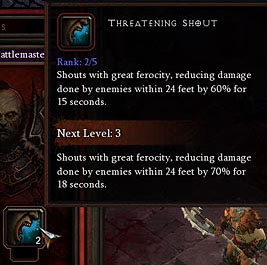Difference between revisions of "Skill"
m |
TheWanderer (talk | contribs) |
||
| Line 39: | Line 39: | ||
* '''[[Active skill]]s''' - Skills where effects are activated by the player. | * '''[[Active skill]]s''' - Skills where effects are activated by the player. | ||
* '''[[Passive skill]]s''' - Skills where effects are activated automatically, by the computer or by special events. | * '''[[Passive skill]]s''' - Skills where effects are activated automatically, by the computer or by special events. | ||
| + | * Skill [[Rank]]s | ||
Revision as of 00:23, 16 October 2009
Skills are what all abilities the character classes in Diablo III have are called. A skill includes regular physical abilities like Cleave or a magical spell like disintegrate. While skills is the official name, players often refer to them as spells, talents, abilities, and similar terms. These are just synonyms, and are frequently interchangeable in use.
Worth noting is that monsters can also use skills, but often not a Character skill. Primarily caster monsters have skills/spells, but others as well. Monster skills include all their abilities besides their "auto attack".
Useful skill links:
- Skill runes
- Barbarian skills - Barbarian-specific skill design.
- Berserker Skill Tree - Berserker skills.
- Juggernaut Skill Tree - Juggernaut skills.
- Battlemaster Skill Tree - Battlemaster skills.
- Barbarian skill archive - Removed Barbarian skills.
- Monk skills - Monk-specific skill design.
- Skill Tree A - A skills.
- Skill Tree B - B skills.
- Skill Tree C - C skills.
- Wizard skills - Wizard-specific skill design.
- Conjuring Skill Tree - Conjuring skills.
- Arcane Skill Tree - Arcane skills.
- Storm Skill Tree - Storm skills.
- Wizard skill archive - Removed Wizard skills.
- Witch Doctor skills - Witch Doctor-specific skill design.
- Zombie Skill Tree - Zombie skills.
- Spirit Skill Tree - Spirit skills.
- Voodoo Skill Tree - Voodoo skills.
- Witch Doctor skill archive - Removed Witch Doctor skills.
- Signature skills - Skills that define characters.
- Active skills - Skills where effects are activated by the player.
- Passive skills - Skills where effects are activated automatically, by the computer or by special events.
- Skill Ranks
Known Skills
We know a fair number of skills from seeing them in demonstrations, and from taking notes of them at BlizzCon in October 2008 and 2009. More than 30 skills each are known for the Barbarian, Wizard and Witch Doctor, while fewer of the Monk's skills have yet been revealed. Click to the appropriate pages in the links above to learn the names and functions of all known skills.
Skill Mechanics
One major change from Diablo 2 is that the various snaking lines of skill prerequisites are gone. In Diablo 3 skills are enabled by spending skill points. In the BlizzCon 2009 build, a character had to place 15 points in various skills before using Tier 4 skills. Which skills you put those points on that tier and below is up to you. This general tier-mechanic has stayed the same since BlizzCon 2008, so will likely carry on to the final game.
Skill Trees
The skills of each character class is divided into three skill trees. They were originally much more individual, but is now primarily a way to categorise skills for each class. There is now just one skill menu per each character, allowing players to pick from any of the three skill trees on that page, depending on how many skill points they have spent in total, rather than per individual tree.
Each tree has about 10-12 skills each, divided into 6 "tiers", of 1-3 skills each.
This is, of course, subject to further change as the development process grinds on.
Skill Caps
Bashiok spoke to this issue in a forum post in May 2009. [1]
- Currently we’re envisioning the majority of skills to be capped at 5 points, to begin with. As a form of progression we're planning for players to be able to increase the point caps of skills. More than likely to a maximum of 15. It's a system that’s still under heavy design, but the fact of choosing and increasing key skills beyond their initial cap is important to this new unified tier system.
Blizzard has not given any word on how these increased skill caps would be enabled, whether by Clvl requirements, quests/in-game achievements, item bonuses, or something else. Like the other features, it's under construction and will change between now and the game's release.
There has been talk of runes affecting the skill caps, or perhaps a secondary limited "skill point" system that lets you increase the cap of individual skills further.
Skill Display
The finer points of the skill hover have changed and evolved during the game's development, and will continue to do so. Expect further changes.
Hovering on a skill produces a visual like the one seen to the right. The name of the skill is displayed, along with the current and maximum points that a character may spend in it. The current function is shown, as is the increases you will enjoy with another point.
One prime difference from Diablo II is the slot for a skill rune that you see below the skill, in the skill tree. Only active skills (as far as is known) have slots for skill runes, and skill runes can be freely socketed and swapped in and out. (Subject to change during further development.) See the skill runes page for more details.
Active and Passive Skills
Diablo III skills are either "active" or "passive." There are many more passive skills than active skills. At Blizzcon in October 2008 (a very preliminary build of the game), each skill tree was set up in tiers, with 4 or 5 skills per tier. On each tier, one or two were active and the rest were passive.
Active skills are used by clicking their icon, and are generally direct attacks; things like Soul Harvest, Hammer of the Ancients, or Magic Missile. Active skills attack, cast a protective armor, stun monsters, etc.
Passive skills grant the character some sort of bonus that is always in effect. Passive skills do not need to be cast to activate them; they give a bonus all the time, as soon as points are placed into them. These are skills and spells like Efficient Magics or Power of the Battlemaster. (No passive Witch Doctor skills have yet been named.) Passive skills boost the damage of other spells, lower the mana cost of casting them, increase their duration, etc. Passive skills were often called "masteries" in Diablo II, and that term is still applicable to many of them in Diablo III.
Skills Define Characters
D3 Lead Designer Jay Wilson discussed how skills drive game development, and vice versa, in a December 2008 interview with 1up.com[2]. The D3 team later coined the expression "signature skills" to express this further. Skills that truly guides the rest of the development of a class.
- 1UP: In creating this game, would you say that the character classes and their powers drive the rest of the game, or are their powers created as a result -- or solution -- to problems presented by the game?
- JW: Probably the best way to describe it is that initially, when we're doing skills for a class, we're not thinking anything except "what makes this class awesome? Why do I care about this guy?" Then you say, "Because he can hit the ground and create a small localized earthquake that destroys everything in front of him." That sounds pretty awesome; that sounds like a guy that I'd want to play. So early on, that's really our fixation: What is going to make this class sing? But that only really drives the first half-dozen skills. After that, we start getting into what mechanics have we put in the game that we want this class to take advantage of. For example, with the Wizard, we gave her a passive skill that causes enemies to drop mana orbs -- just like health orbs. So that's a mana-recovery mechanic for her; it plays into her resource and plays into the health-orb system.
- So there, we just said, "We need a recovery mechanism for her -- what would work? Well, we can give her something similar that we already give for health." But then that doesn't mean anything for the Barbarian since he uses a completely different resource. For him, we tend to focus on skills that make him play in a way that's interesting. His "fury resource" is designed to drive the player forward, like a Barbarian, because he's very tough and is a close-quarters combatant. He wants to move forward, because the mechanic is "I have a lot of fury, which helps me deliver a lot of damage, but I'm going to lose it just sitting around." It makes him very aggressive, which is what we wanted out of the character. So that was driven by [the concept of] how do we want this guy to play. Very aggressively, and hence we built this mechanic.
- And lastly, [there's] the monster design. As we get further and further into the game, our goal is to make monsters that we can't figure out how the player can defeat [with the existing skills] and give the player the tools they need to defeat them. So the design of the monsters has a direct relationship to the design of the classes. That's kind of an ongoing thing; we [decide] "Let's create a monster that has really debilitating rooting attacks that just get you stuck when you encounter them." Then we see that this really screws with the Barbarian, so we give him a skill that lets him break out of roots so that he can counter that. Those things are interesting and allow for the player to have a broader, deeper character. On the other hand, we don't want to go too far -- a lot of mechanics of World of WarCraft are based heavily on control, and we want to make sure that Diablo 3 stays mostly a combat game based mostly on attacks.
School of Skills
Skills currently lack a lot of information of what type of skill they are. When the game is released, we will be able to decipher a lot more of these. For now, terms such as "schools" of skills (or spells) are generally speculation to make it easier to understand the mechanics behind them.
All abilities, spells etc are classed as "Skills" at the moment, but this could also change. DiabloWiki is simplifying this by talking about three types of skills:
- Magical Skills
- Supernatural Skills
- Extraordinary Skills
Magical skills are all types of skills that use mana or is of a magical nature, like a monster being able to summon allies, despite not having mana, or being a traditional caster.
Supernatural skills are the type of feats a Barbarian typically would do. They are not magical as such, but they don't really follow traditional physical laws.
Extraordinary skills are just that: Extraordinary. Very strong monster/character, someone who can jump very high, use a chemical compound to "breathe fire", etc.
Development
The first sighting of skill trees was in the BlizzCon 2008 build where more than 50 skills were shown for the Wizard and Barbarian and placed in three individual trees, similar to how the system worked in Diablo II and World of WarCraft. Each 5 points spent in a tree opened a new tier to put skill points in. That game design favoured specializing in one tree, and did not have any prerequisites, instead totally based on points spent in each tree.
At that point there were just 4 tiers of skills. Tier 1 was available at level 1, Tier 2 at level 5, then at 10 and 15. There was a fifth tier at level 20, but no skills were displayed in it. The image to the right is from that era.
The D3 Team mentioned that they were experimenting with allowing certain skills to have higher skill caps, but did not give details such as if it would be Clvl based, item based, points spent or something completely different.

This layout had changed a great deal by March 2009, when the next skill tree image was released. You see it to the left. The basic form remains, but the skills are staggered out over more tiers. Also note that the tiers are not labelled; they may no longer proceed at 5 point intervals. It's also possible that tiers will grow longer, with higher level skills being added as development proceeds.

Bashiok elaborated on this in a forum post in May 2009 [3] saying the trees had been unified to one single page that "allows you to spend wherever you like." This overhaul of the skill system merging the skill trees but the group of skills kept their skill tree names.
The skill requirement still opened up in tiers, but opened up to all trees at the same time, enabling a player to pick low level skills in one tree, continuing with medium level skills in another and high level skills in the third.
The general theory of skill trees is to encourage character specialization, but not force cookie cutter style character builds. The removal of individual skill trees means that every character can now pick from all the possible skills; this is great in theory, since players can all use whatever skills they want, Tier conflicts permitting. On the other hand, if the skills aren't very well balanced, every character will end up using the same few skills, since those are the best, and the cookie cutter-ism on Battle.net could be insane.
Bashiok defended the design saying it "diversifies the types and amounts of builds available to players," and explaining another advantage is that the D3 Team "don't have to throw in skills that are important, such as damage mitigation, all over the place."
"Every barbarian is probably going to want whirlwind. And why not? What this tree style allows for, and one reason we’re pretty keen on it, is that we aren’t saying “You’re a ‘berserker’ barbarian, you can’t have whirlwind”. Instead, you’re a barbarian!, pick the key skills that define you and your character as you want them to be."
Exactly how the D3 Team pulls this off without making every character use the same "best" skills is something worth monitoring as the game continues its development.
The overhaul did also see the removal of many relatively redundant skills, primarily removing passive skills.
References
- Diii.net Skill Trees Innovative Overhaul
- 1UP interview with Jay Wilson
- WWI 2008: Denizens of Diablo Panel
- Skill Tree Graphics Assistance thread at Diii.net
- Full Barbarian Skill Trees and Stats
- Full Monk Skill Tree Stats and Discussion
- Full Witch Doctor Skills
- Full Wizard Skill Trees






